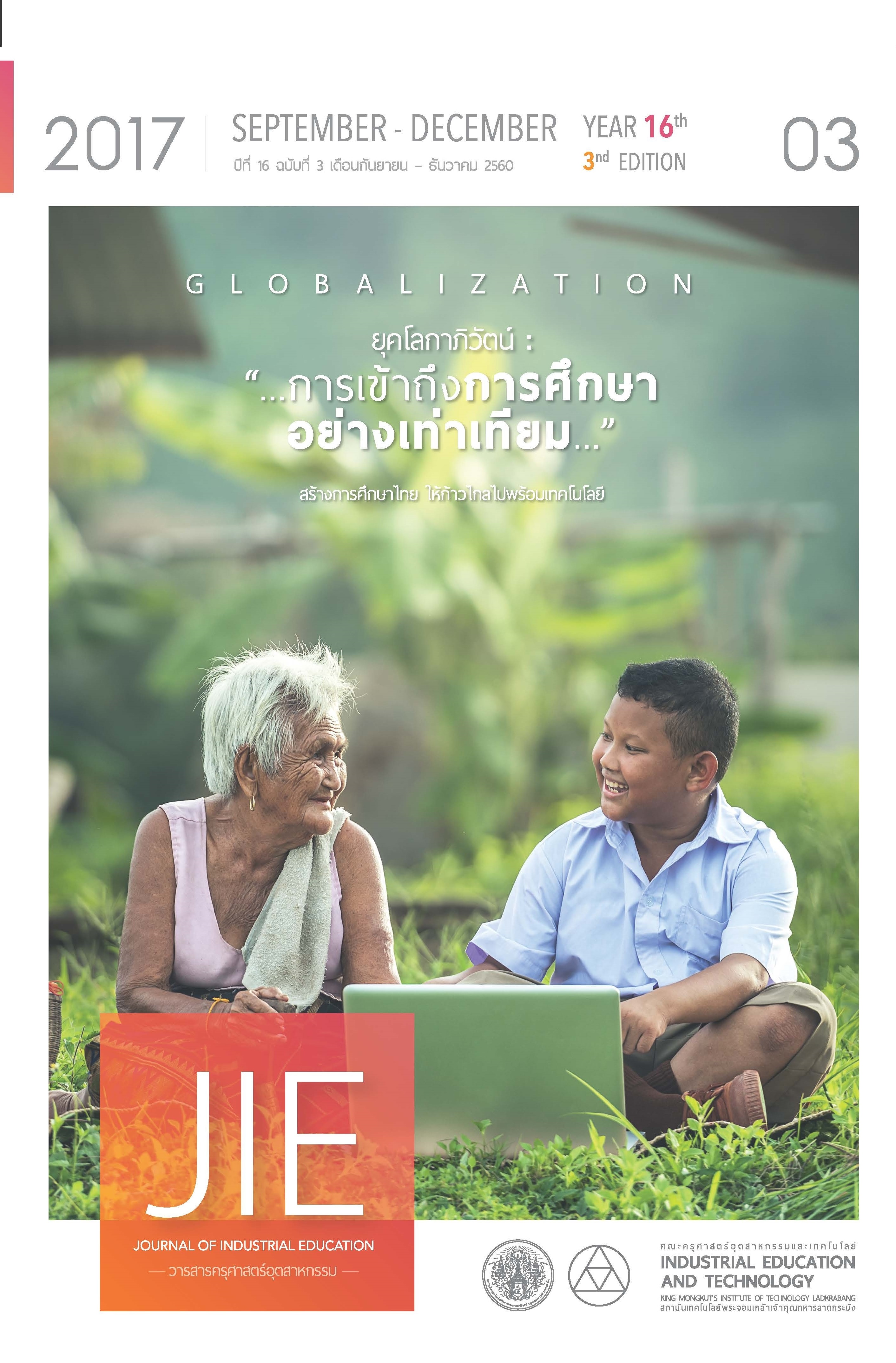CONSTRUCTION OF A COMPUTER COMPETENCIES ASSESSMENT SET FOR THE OCCUPATIONS AND TECHNOLOGY SUBJECT FOR MATTAYOMSUKSA 1
Keywords:
Generated Assessment model, Computer Competencies, Cut-off score, Distracter efficiency and Reliability, TestAbstract
The purposes of this study were to : 1) create the Computer Competencies Assessment for students in secondary schools (Grade 7). 2) validate the quality, content validity, discrimination, difficulty, distracter efficiency and reliability 3) study the effect of implementing the Computer Competencies Assessment and the developed cut-off scores. The sample group, drawn from multi-stage random sampling, consisted of 420 students from secondary schools in the Secondary Educational Service Area Office 5. The research instruments included a test of knowledge, an Affective Domain observation form and a practical skill test. The statistical calculations involved the index of Item Objective Congruence, Lovette’s reliability calculations, and Rater Agreement Index And Berk’s cut-off score.
The results of the study were as follows :
- The developed Computer Competencies Assessment consists of 1.1) 3 sets of the test to measure the knowledge about computers, Information and Communications Technology. Each set consists of 30 questions. 1.2) 2 sets of Observation protocols about the virtues and values of technology. 1.3) 3 sets of a practical skill test of computer use and communicate and Microsoft Word program. evaluated by using a scoring rubric.
- The quality of the developed Computer Competencies Assessment is found to be appropriate. The IOC was 0.67 to 1, the discrimination was 0.25 to 0.93, the difficulty was 0.22 to 0.77, the distracter efficiency was 0.06 to 0.48 , the reliability was 0.92 to 0.93, IOC of Affective Domain was 0.67 to 1, with the Rater Agreement Index of 0.86 to 0.90 and the Psychomotor Domain with IOC was 0.67 to 1, Rater Agreement Index is equal to 0.89 to 0.95.
- When implementing the Computer Competencies Assessment, it was found that the students gained higher scores in the posttest than the pretest. The test’s cut-off scores equal 13 to 15 from the full score of 30. The Affective Domain had the cut-off score equal to 4 points from the full score of 6 points and the Psychomotor Domain’s cut-off scores equal 6 to 12 from the full scores of 15 to 24 while the validity value is between 0.76 to 0.95.
References
[2] Phichit Ritcharun. N.2005. Measurement Evaluation. Bangkok : House of Kermyst.
[3] Ministry of Education. N.2008. The basic education Core Curriculum B.E. 2551. Bangkok : Chumnumsahakonkankaset Thailand.
[4] Witsawa Thobuddee. N.2008. A Workshop on Development Knowledge of Computer Skills for Students in Secondary School Grade 8 Belong to Educational Service Area Office at Amnatcharoen. Master degree of Education Research and Evaluation, Ubonratchathani Rajabhat University.
[5] Nongnit Manorat. N.2007. Constructing Tests of Practice Skills and Affective Domain in the Learning Strand of Career and Technology for Student in Primary School Grade 4 Entitled Housework, Handwork, and Inventive Work. Master degree of Educational Measurement, Mahasarakham University.
[6] Lahore, L. 2008. Community College Students and Differences between Computer Skills Self-Accessment and Objective Computer-Based Skills Accessment. Retrieved July 3, 2013, from https://dl.acm.org/citation.cfm?id=1559629
[7] Fishbeck, K. 2009. The Assessment and Perception of Basic Computer Skills of Freshmen at The University of Mary. Retrieved July 3, 2013, from https://books.google.co.th/ books?id=glTxSAAACAAJ
[8] Subramaniam, M. 2007. The Development of Information Technology Curricula Guidelines and Skill Standards : Toward a Theory of the Emergence of Computing Degree Programs. Retrieved July 3, 2013, from https://fsu.digital.flvc.org/islandora/object/fsu:176030/datastream/PDF/view
[9] Suvaree Reengern. N.2007. Situations and Problems of Academic Administration of The Vocational and Technology from student Level 3-4 belong to Educational Service Area Office 2 at Ratchaburi. Master degree of Education Educational Administration, Muban Chombueng Rajabhat University.
[10] Wipaporn Saesuntia. N.2010. A Construction of Knowledge Test and Performance Test in Career and Technology Student in Primary School Grade 6. Master degree of Education Research and Evaluation, Phetchabun Rajabhat University.
[11] Thanyakorn Arunsot. N.2005. The Development of Performance Test in Computer Subject Using Microsoft Word Program for Secondary in Schools Belong to Educational Service Area Office at Yasothon. Master degree of Education Research and Evaluation, Ubonratchathani Rajabhat University.
[12] Suwimon Wongwanich. N.2004. Performance Testing. Bangkok : Faculty of Education, Chulalongkorn University.
[13] Bunchom Sisaat. N.2013. Preliminary Research. 9th ed. Bangkok : Suwiriyasan.
[14] Bunriang Khachonsin. N.2000. Education Research Methodology. Bangkok : P N Kanphim.
[15] Bunchoet Phinyoanantaphong. N.1984. Criterian Referanced Test : Concept and Method. Bangkok : Odianstore.
[16] Chatsiri Piyapimonsit. N.2001. Rater Agreement Index. Retrieved 5 October, 2013, from https://www.watpon.com/Elearning/index_relia.pdf
[17] Panita Wanphirun, et al. N.2012. Information and Communication Technology. Bangkok : Phatthanakhunnaphapwichakan.
[18] Luan Saiyot and Angkhana Saiyot. N.1996. Measurement Techniques. Bangkok : Suwiriyasan.
[19] Luan Saiyot and Angkhana Saiyot. N.2000. Affective Domain. Bangkok : Suwiriyasan.
[20] Somneuk Phatthiyathani. N.2015. Educational Measurement. 10th ed. Kalasin : Prasankanphim.
[21] Chatsiri Piyapimonsit. N.2001. Scoring Rubrics. Retrieved 5 October, 2013, from https://ww.watpon.com/Elearning/mea5.htm
[22] Yanisa Ussasongpon Pariyaporn Tungkunanan and Boonchan Sisan. 2016. Variables Affecting Scores of Ordinary National Education Test(O-Net) of Mathayomsuksa 3 Students in The Secondary Educational Service Area Office 3. Journal of Industrial Education, 15(3), p. 135-136.
Downloads
Published
How to Cite
Issue
Section
License
"The opinions and contents including the words in papers are responsibility by the authors."
"ข้อคิดเห็น เนื้อหา รวมทั้งการใช้ภาษาในบทความถือเป็นความรับผิดชอบของผู้เขียน"



